Orange, Vaucluse
Orange (French pronunciation: [ɔʁɑ̃ʒ]; Provençal Occitan: Aurenja in classical norm or Aurenjo in Mistralian norm) is a commune in the Vaucluse Department in the Provence-Alpes-Côte d'Azur region in southeastern France, about 21 km (13 mi) north of Avignon. It has a primarily agricultural economy.
Orange | |
|---|---|
 Aerial view of central Orange | |
.svg.png) Coat of arms | |
Location of Orange 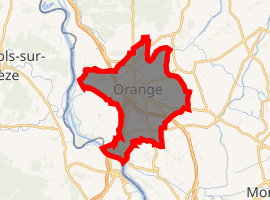
| |
 Orange  Orange | |
| Coordinates: 44°08′18″N 4°48′35″E | |
| Country | France |
| Region | Provence-Alpes-Côte d'Azur |
| Department | Vaucluse |
| Arrondissement | Carpentras |
| Canton | Orange |
| Government | |
| • Mayor (2008–2014) | Jacques Bompard |
| Area 1 | 74.2 km2 (28.6 sq mi) |
| Population (2017-01-01)[1] | 28,919 |
| • Density | 390/km2 (1,000/sq mi) |
| Time zone | UTC+01:00 (CET) |
| • Summer (DST) | UTC+02:00 (CEST) |
| INSEE/Postal code | 84087 /84100 |
| Elevation | 24–127 m (79–417 ft) (avg. 50 m or 160 ft) |
| 1 French Land Register data, which excludes lakes, ponds, glaciers > 1 km2 (0.386 sq mi or 247 acres) and river estuaries. | |
| UNESCO World Heritage Site | |
|---|---|
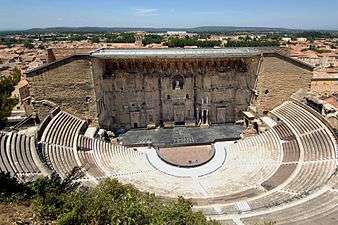 | |
| Includes | Roman Theatre of Orange and Triumphal Arch of Orange |
| Criteria | Cultural: iii, vi |
| Reference | 163 |
| Inscription | 1981 (5th session) |
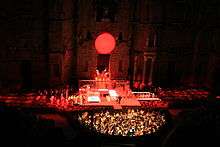
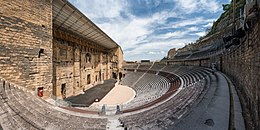
History
Roman Orange was founded in 35 BC by veterans of the second legion[2] as Arausio (after the local Celtic water god), or Colonia Julia Firma Secundanorum Arausio in full, "the Julian colony of Arausio established by the soldiers of the second legion." The name was originally unrelated to that of the orange fruit, but was later conflated with it (see Orange (word)).
A previous Celtic settlement with that name existed in the same place, and a major battle, which is generally known as the Battle of Arausio, had been fought in 105 BC between two Roman armies and the Cimbri and Teutones tribes.
Arausio covered an area of some 70 ha (170 acres) and was well-endowed with civic monuments; in addition to the theatre and arch, it had a monumental temple complex and a forum.
 Orange in the Table Peutinger
Orange in the Table Peutinger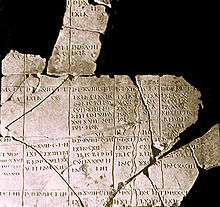 Roman cadaster of Orange
Roman cadaster of Orange
It was the capital of a wide area of northern Provence, which was parcelled up into lots for the Roman colonists. "Orange of two thousand years ago was a miniature Rome, complete with many of the public buildings that would have been familiar to a citizen of the Roman Empire, except that the scale of the buildings had been reduced – a smaller theater to accommodate a smaller population, for example."[3] It is found in both the Tabula Peutingeriana and Le cadastre d'Orange maps.
The town prospered, but was sacked by the Visigoths in 412. It had, by then, become largely Christianized, and from the end of the third century constituted the Ancient Diocese of Orange. No longer a residential bishopric, Arausio, as it is called in Latin, is today listed by the Roman Catholic Church as a titular see.[4] It hosted two important synods, in 441 and 529. The Second Council of Orange was of importance in condemning what later came to be called Semipelagianism.
The sovereign Carolingian counts of Orange had their origin in the eighth century, and passed into the family of the lords of Baux. From the 12th century, Orange was raised to a minor principality, the Principality of Orange, as a fief of the Holy Roman Empire. During this period, the town and the principality of Orange belonged to the administration and province of Dauphiné.

When William the Silent, count of Nassau, with estates in the Netherlands, inherited the title Prince of Orange in 1544, the principality was incorporated into the holdings of what became the House of Orange-Nassau. This pitched it into the Protestant side in the Wars of Religion, during which the town was badly damaged. In 1568, the Eighty Years' War began with William as stadtholder leading the bid for independence from Spain. William the Silent was assassinated in Delft in 1584. His son, Maurice of Nassau (Prince of Orange after his elder brother died in 1618), with the help of Johan van Oldenbarnevelt, solidified the independence of the Dutch republic. The United Provinces survived to become the Netherlands, which is still ruled by the House of Orange-Nassau. William, Prince of Orange, ruled England as William III of England. Orange gave its name to other Dutch-influenced parts of the world, such as the Oranges (West Orange, South Orange, East Orange, Orange) in New Jersey and the Orange Free State in South Africa.
The city remained part of scattered Nassau holdings until it was repeatedly captured by the forces of Louis XIV during his wars of the late 17th century. The city was occupied by France in 1673, 1679, 1690, 1697 and 1702-1713 before it was finally ceded to France in 1713 under the Treaty of Utrecht.[5] Following the French Revolution of 1789, Orange was absorbed into the French département of Drôme, then Bouches-du-Rhône, then finally Vaucluse. However, the title remained with the Dutch princes of Orange.
Orange attracted international attention in 1995, when it elected a member of Front National (FN), Jacques Bompard, as its mayor. Bompard left the FN in 2005 and became a member of the conservative Movement for France until 2010.
Orange was also home to the French Foreign Legion's armored First Foreign Cavalry Regiment. The regiment officially moved to Carpiagne (fr:Camp de Carpiagne) on July 10, 2014.
Population

The city of Orange is the 3rd largest town of Vaucluse by population after Avignon and Carpentras.
In 2013, the municipality had 29,193 residents. The evolution of the number of inhabitants is known throughout the population censuses carried out in the town since 1793. From the twenty-first century, censuses of municipalities with more than 10 000 inhabitants are held annually as a result of a sample survey, unlike other cities that have a real census every five years
Main sights
The town is renowned for its Roman architecture, and its Roman theatre, the Théâtre antique d'Orange, is described as the most impressive still existing in Europe. There is some debate about when the arch was built, but current research that accepts the inscription as evidence favours a date during the reign of emperor Augustus. The arch also contains an inscription dedicated to emperor Tiberius in AD 27, when it was reconstructed by emperor Tiberius to celebrate the victories of Germanicus over the German tribes in Rhineland. The arch, theatre, and surroundings were listed in 1981 by UNESCO as a World Heritage Site.
The Musée (Museum) displays the biggest (7.56 x 5.90 m) cadastral Roman maps ever recovered, etched on marble. They cover the area between Orange, Nîmes, and Montélimar.
Culture
In 1869, the Roman theatre was restored and has been the site of a music festival. The festival, given the name Chorégies d'Orange in 1902, has been held annually ever since, and is now famous as an international opera festival.
In 1971, the "New Chorégies" were started and became an overnight, international success. Many top international opera singers have performed in the theatre, such as Barbara Hendricks, Plácido Domingo, Montserrat Caballé, Roberto Alagna, René Pape and Inva Mula. Operas such as Tosca, Aida, Faust, and Carmen have been staged here, many with a sumptuous staging and also receiving outstanding acclaim.
The Roman theatre is one of three heritage sites at which the Roman wall remains.
Transportation
SNCF offers rail service north to Lyon and Paris, and south to Avignon and Marseille.
Sister cities
Orange is twinned with:
|
|
It is also member of the Association of Orange cities, together with:

.svg.png)

Climate
Orange features a humid subtropical climate (Cfa), with just too much rainfall in summer to have a 'Mediterranean' (Csa) classification. Summers are hot and relatively dry. Most rainfall occurs in spring and autumn, though with gentle temperatures. Winters are mild, but harsh frost and snow are not unheard of.[7] On June 28, 2019, the temperature hit 41.0 °C.[8][9]
| Climate data for Orange, France (altitude 53m, 1981–2010 averages, extremes 1952–present) | |||||||||||||
|---|---|---|---|---|---|---|---|---|---|---|---|---|---|
| Month | Jan | Feb | Mar | Apr | May | Jun | Jul | Aug | Sep | Oct | Nov | Dec | Year |
| Record high °C (°F) | 20.5 (68.9) |
23.0 (73.4) |
27.2 (81.0) |
31.2 (88.2) |
34.5 (94.1) |
41.0 (105.8) |
40.7 (105.3) |
42.6 (108.7) |
35.8 (96.4) |
30.9 (87.6) |
24.6 (76.3) |
20.2 (68.4) |
42.6 (108.7) |
| Average high °C (°F) | 9.9 (49.8) |
11.7 (53.1) |
15.6 (60.1) |
18.6 (65.5) |
23.2 (73.8) |
27.4 (81.3) |
30.8 (87.4) |
30.2 (86.4) |
25.2 (77.4) |
20.0 (68.0) |
13.7 (56.7) |
10.1 (50.2) |
19.7 (67.5) |
| Daily mean °C (°F) | 5.8 (42.4) |
7.0 (44.6) |
10.4 (50.7) |
13.2 (55.8) |
17.5 (63.5) |
21.4 (70.5) |
24.4 (75.9) |
23.9 (75.0) |
19.7 (67.5) |
15.3 (59.5) |
9.7 (49.5) |
6.4 (43.5) |
14.6 (58.3) |
| Average low °C (°F) | 1.6 (34.9) |
2.4 (36.3) |
5.2 (41.4) |
7.8 (46.0) |
11.8 (53.2) |
15.4 (59.7) |
18.0 (64.4) |
17.6 (63.7) |
14.1 (57.4) |
10.6 (51.1) |
5.7 (42.3) |
2.7 (36.9) |
9.4 (48.9) |
| Record low °C (°F) | −13.4 (7.9) |
−14.5 (5.9) |
−9.7 (14.5) |
−2.9 (26.8) |
1.3 (34.3) |
5.7 (42.3) |
9.5 (49.1) |
8.3 (46.9) |
3.1 (37.6) |
−1.6 (29.1) |
−5.8 (21.6) |
−14.4 (6.1) |
−14.5 (5.9) |
| Average precipitation mm (inches) | 51.0 (2.01) |
39.4 (1.55) |
43.9 (1.73) |
66.0 (2.60) |
65.3 (2.57) |
38.3 (1.51) |
36.9 (1.45) |
42.3 (1.67) |
102.0 (4.02) |
92.9 (3.66) |
75.4 (2.97) |
55.7 (2.19) |
709.1 (27.92) |
| Average precipitation days (≥ 1.0 mm) | 5.7 | 4.9 | 4.9 | 7.2 | 6.3 | 4.7 | 3.0 | 3.5 | 5.5 | 7.2 | 6.6 | 6.4 | 66.0 |
| Average relative humidity (%) | 77 | 74 | 69 | 66 | 66 | 64 | 71 | 78 | 78 | 79 | 71 | 77 | 72.5 |
| Mean monthly sunshine hours | 132.0 | 137.1 | 192.5 | 230.4 | 264.6 | 298.9 | 345.3 | 310.7 | 237.6 | 187.1 | 135.2 | 123.8 | 2,595.2 |
| Source 1: Météo France[10] | |||||||||||||
| Source 2: Infoclimat.fr (humidity 1961–1990)[11] | |||||||||||||
See also
References
- "Populations légales 2017". INSEE. Retrieved 6 January 2020.
- europeanfocus.com
- Ina Caro, "The Road from the Past: Traveling through History in France".
- Annuario Pontificio 2013 (Libreria Editrice Vaticana 2013 ISBN 978-88-209-9070-1), p. 845
- Cru, Jacques (2001). Histoire des Gorges du Verdon jusqu’à la Révolution (in French). p. 220. ISBN 2-7449-0139-3. coédition Édisud et Parc naturel régional du Verdon
- "Jarosław Official website – Partner Cities".

- Climate Summary for Orange, France ad
- https://www.infoclimat.fr/observations-meteo/temps-reel/orange-caritat/07579.html?metar
- http://www.meteociel.fr/temps-reel/obs_villes.php?code2=7579&jour2=28&mois2=5&annee2=2019&envoyer=OK
- "Orange (84)" (PDF). Fiche Climatologique: Statistiques 1981–2010 et records (in French). Meteo France. Archived from the original (PDF) on 30 March 2018. Retrieved 29 March 2018.
- "Normes et records 1961-1990: Orange-Caritat (84) - altitude 53m" (in French). Infoclimat. Archived from the original on 5 September 2011. Retrieved 29 March 2018.
External links
| Wikimedia Commons has media related to Orange (Vaucluse). |
| Wikivoyage has a travel guide for Orange (France). |
- Roman Theatre and Museum official website (in English)
- Town council website (in French)
- Tourist office website
